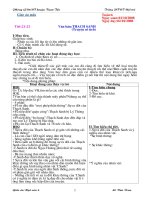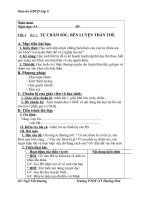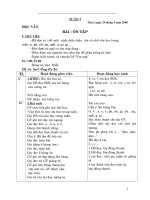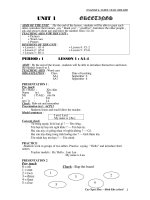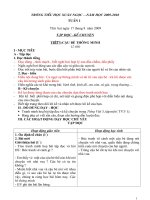TA 6 1 da chinh sua 1 cot
Bạn đang xem bản rút gọn của tài liệu. Xem và tải ngay bản đầy đủ của tài liệu tại đây (695.3 KB, 200 trang )
P: 22-08-2008 Period 1
T: 25-08-2008 Hướng dẫn cách học
I. Objectives:
- T helps Ss get acquainted with the subject and the ways to study it effectively .
- After the lesson, Ss will be able to know about the lesson clearly and have inspiration to
study it.
II.Preparation:
- Text book,chalk, exbook…..
III. Teaching procedure
1. Class organization.
Class 6A1 ............./ ......... Absent …………………………………………..
…………..……………
Class 6A2 ............./ ......... Absent …………………………………………..
…………..……………
2. Oral test:
- T checks the preparation of Ss
3. New lesson:
A. Warm- up:
- Chat with Ss about some funny stories in studying this subject.
B. Presentation:
∗
Getting acquanted with the subject.
- It’s a difficult but interesting subject with 16 Units, each unit can be devided into 6 lessons.
- Each term contains 8 Units.
- whole school year has 105 periods in which : the first term has 54 periods and the other has
51.
- Ss has 9 periods for Revision and Testing.
∗
Guides to study effectively:
- T presents the way to study effectively and gives some techniques:
+ Practice regularly.
+ Pay much attention to the lesson during the time in the class.
+ Do exercises right after studying inthe class and listening to the T carefully.
+ Spend much time to practice at home and in the classroom with their classmates.
+ Be much self-confident in all studying activities.
∗
Books and notebooks
+ a Student book + a Work book
+ 2 notebooks
4.Consolidation:
- Greetings: Hello, hi, good morning …
- 1 -
- Stand up, sit down, open your book, close your book….
5. Homework:
- Prepare the new lesson
- 2 -
K6 Date of planning: 15-08-2008
Date of teaching: 17-08-2008
Period: 1
Unit 1: Greetings
Lesson 1: A. 1-4
A. Aims:
- After the lesson, Ss will be able to greet the others and say their name in English.
B. Language Contents:
1. Vocabulary:
2. Grammar:
C. Teachinh aids
- Cassette and tape, text book.
D. Teaching Methods
E. Procedures:
I. Class organization:
II. Check old lesson
III. New lesson
1. Warm- up:
- Chatting.
2. Preparation:
a, A1: Listen and repeat:
- Present the way to greet in English.
-Pronounce the phrases first, then ask ss to repeat aloud.
- Ss listen to the tape to listen to the native English.
- Ask Ss to practice pronouncing after aloud.
- Call some Ss to practice in front of the class.
b, A2: Practice:
- T sets the situation .
- T does with one or two ss to make it as example.
- Get Ss to practice in pairs.
Ex: Lan: Hello.
Mai: Hi.
- Call some pairs to pratice .
- Give some remarks.
c, A3: Listen and repeat:
- T explains the way to introduce the name to the others: two ways:
Ex: you are Lan, so you can say: I am Lan.
or My name is Lan.
- Get ss to pronounce after aloud.
- 3 -
- T speaks first as a model: I am Tien.
or: My name is Tien.
- Call some Ss to introduce their names.
3.Practice:
- Ask Ss to introduce their names.
- Call all Ss to practice as the way to know their names.
4. Free practice
-Ask Ss ask and answer about them. Introduce themselve
5. Consolidation
- Ask some good pairs to practice both greeting and introducing thier names.
6. Homework:
- Practice speaking at home.
- 4 -
K6 Dte of planning: 16/08/2009
Date of teaching: 18/08/2009
Period: 2
Unit 1: Greetings
Lesson 2: A. (5-8)
A. Aims:
- After the lesson, Ss will be able to greet each other and show their interest on their friends’ health in
English.
B. Language Contents:
1. Vocabulary:good morning/afternoon/evening
2. Grammar: How are you? – I’m fine thanks
C. Teaching aids
- Cassette and tape, text book.
D. Teaching Methods
E. Procedures
I.Class organization.
II.Check old lesson
- Call some Ss to practice greeting and introducing their names in front of the class.
- Ask some ss to write the new words
III. New lesson
. 1. Warm- up:
- Introduce the lesson by giving situation of speaking.
2. Preparation:
-Listen and repeat:
- Present the way to greet formally in English.
- Read the dialogue first, then ask ss to repeat aloud.
- Ss listen to the tape to listen to the native English.
- Ask Ss to practice reading after aloud.
- Call some Ss to practice in front of the class.
3.Practice
- T sets the situation .
- T does with one or two ss to make it as example.
- Get Ss to practice in pairs.
Ex: Lan: Hello, Mai.
Mai: Hi, Lan.
Lan: How are you?
Mai: I’m fine,thanks.And you?
Lan: Fine, thanks.
- 5 -
- Call some pairs to pratice .
- Give some remarks.
4. Free practice.
- T explains the way to practice.
- Get ss to practice individually.
- Call some Ss to practice writing on the board.
- Get the others to give teir remarks.
- T gives some remarks and the correct answers.
- Ss copy it to their exercise book.
5. Consolidation:
- Ask some good pairs to practice both greeting and introducing their names.
6. Homework:
- Practice speaking at home.
- 6 -
K6 Date of planning: 17/08/2009
Date of teaching: 19/08/2009
Period 3
Unit 1: Greetings
Lesson 3: B. (1-6)
A: Aims
- After the lesson, Ss will be able to greet eachothers basing on the time of the day and the way to
express their concern about their friends’health.
B: Language Contents
Vocabulary: good night, goodbye,
Grammar: we’re … = we are…..
C: Teaching aids
- Cassette and tape, text book.
D: Teaching Methods
E: Procedures:
I.Class organization.
II. Check old lesson
- Check the preparation of Ss.
III. New lesson
1. Warm- up:
- Chatting.
2. Preparation:
- Listen and repeat:
- Present the way to greet in English.
- Ss listen to the tape to listen to the native English.
-Pronounce the phrases, then ask ss to repeat aloud.
- Ss listen to the tape to listen to the native English and repeat.
- Ask Ss to practice pronouncing after aloud.
- Call some Ss to practice in front of the class.
3: Practice:
- T presents the task.
- T does with one or two ss to make it as example.
- Get Ss to practice in pairs.
Ex: Lan: Good afternoon.
Mai: Good afternoon .
- Call some pairs to pratice .
- Give some remarks.
- Listen and repeat:
- 7 -
- T sets the situation.
- Play the tape for Ss to practice listening.
- Ask Ss to repeat after the tape.
- Get Ss to practi e reading the dialogue in pairs.
- Call some pairs to practice.
4. Free practice
- Ask Ss to read the part B3a once again.
- Explain the tasks.
- Ask Ss to practice writing individually.
- Call some Ss to read their completed dialogue aloud.
5. Consolidation:
- Ask some good pairs to practice with their real names and time of the day.
6. Homework:
- Practice speaking at home.
- Do Ex in the workbook.
- 8 -
K6 Date of planning:22/8/2009
Date of teaching:24/8/2009
Period: 4
Unit 1: Greetings
Lesson 4: C. (1-2)
A. Aims
- After the lesson, Ss will be able to say the numbers from 1 to 20 in English and ask and answer about
the one’s age.
B. Language Contents
1. Vocabulary: Nuber from 1 to 20
2. Grammar: Cuot from one to twenty
C. Teaching aids:
- Cassette and tape, text book.
D. Teaching methods:
- practice with partner
E. Procedure
I.Class organization.
II. Check old lesson
III. New lesson
1. Warm- up:
- Give situation in which Ss have to practice with these expressions:
Good morning Good night
Good afternoon Good bye
Good evening How are you?
2. Preparation:
Listen and repeat:
- Present the tasks.
- Show Ss the numbers written on the sub-board.
- Play the tape For Ss to listen throught the numbers spoken in English.
- Play once again and ask Ss to repeat after .
- Help Ss say the numbers aloud.
3: Practice:
- Ask Ss to practice saying the numbers on their own.
- Call some Ss to practice saying aloud.
- Give some remarks.
- Ask some good Ss to say aloud again.
4. Free practice
Play bingo:
- T gives guessing game:
Ss each write down one number from 1 - 20.
E.g. 5
- Bingo:
- 9 -
- T reads: 10, 7, 19, 15, 20, 6, 8, 1, 4, 11, 14, 2, 3, 16, 5, 17, 12, 18, 13, 9.
- Give Dictation and picture cue drill:
K6 04 821 4076 054 845 832
091 343 3565 0511 82 66 99
08 557 1313 071 839 737
033 612 300 0240 853 199
5. Consolidation
Ask Ss work in pairs
S1: What’s your number?
S2: [ oh-five-double one- eight- two- double six- double nine]
6. Homework:
- Do Ex in the workbook.
- Review all key points.
- 10 -
K6 Date of planning:23/8/2009
Date of teaching:25/8/2009
Period: 5
Unit 1: Greetings
Lesson 4: C. (3→6)
A. Aims:
- Further Practice in Numbers 1 - 20 to count and give telephone numbers and ask and answer about
the one’s age.
B. Language Contents:
Vocabulary: This, number one to twenty
Grammar: -This is Phong
- How old are you ?
- I’m twelve
C. Teaching aids
- Text book. Plan lesson
D. Teaching Methods
- Ask and answer with each other
E. Procedure
1. Class organization
2. Check old lesson
3. New lesson
1. Warm- up:
- Pelmanism:
Use the cards from Lesson 4.
- Jumbled words:
tghie = treniteh = lewtev =
neelve = ytwnet = ntrenouf =
eesvn = ientenen =
2. Preparation:
Listen and repeat:
- Explain the tasks.
- Ask Ss the situation of speaking.
- Play the tape once for Ss to practice listening.
- Play the tape for Ss to repeat after.
- Ask some Ss to read the text aloud.
- Ask Ss to listen once again.
3. Practice:
- 11 -
- Ask Ss to practice asking and answering about their friends’age.
- Do once first as model:
How old are you?
I am ......
- Ask Ss to practice in pairs.
- Call some pairs to practice in front of the class.
- Give some remarks.
4. Free practice
- T says out some numbers and asks Ss to say them in English.
- Ask Ss to practice saying the numbers by asking and answering these given ages:
Nam: 5
Mai: 12 Example exchange:
Hoa: 15 How old is Nam?
Hai: 20 He is five.
Nga: 16
Manh: 4
..............
- T gives some remarks.
5. Consolidation:
- Remind Ss the way to say the numbers.
6. Homework:
- Review the way to say the numbers
- Do Ex in workbook.
- 12 -
K6 Date of planning:25/8/2009
Date of teaching:27/8/2009
Period: 6
Unit 2: At school
Lesson 1: A 1 → 4
A. Aims
- Further Practice in Numbers 1 - 20 and the imperatives in class.
- Ask for and give personal information
B. Language Contents
Vocabulary: come in, sit down, open your book, close your book, stand up,
Grammar:
C. Teaching aids:
- Cassette and tape, text book.
D. Teaching Methods
E. Procedure
I. Class organization:
II. Check old lesson:
III. New lesson:
1. Warm- up:
Noughts and Crosses:
9 - 5 20 - 7 10 + 2
17 + 1 6 + 5 8 / 4
3 - 3 6 * 3 5 + 3
Ss give answers only.
2. Preparation:
Listen and repeat:
- Get Ss to guess what each picture means.
- Pre teach:
- (to) come in
- (to) sit down > < (to) stand up
- (to) open (your book) > < (to) close (your book)
- Checking: Slap the board:
đi vào Đứng lên Mở sách ra
đóng sách lại ngồi xuống
- Play the tape for Ss to listen through.
- Ask Ss to repeat after.
- Get Ss to repeat in chorus.
- Call some Ss to read aloud.
- 13 -
- Get Ss to read aloud again.
3. Practice
- T explains the tasks.
- Ss look at the pictures and do matching in groups.
- Call some Ss to write on the BB.
- T gives some remarks.
4. Free practice
- T makes clera the way to play.
- T does first as model.
- Get Ss to play on their own.
5. Consolidation
- Remember.
+ Come in >< Go out
+ Stand up >< sit down
+ Open your book >< close your book
6. Homework:
- Review the imperatives.
- Do Ex in workbook.
- 14 -
K6 Date of planning:30/8/2009
Date of teaching:31/8/2009
Period: 7
Unit 2: At school
Lesson 2: B 1→ 2
A. Aims:
- “Where do you live?” questions and answers to talk about the places you live.
- After the lesson, Ss will be able to ask and answer the place their friends live.
B. Language Contents:
1. Vocabulary: live, a house, a street, a city
2. Grammar: Where do you live ? → I live on Tran Phu street
C. Teaching aids:
- Cassette and tape, text book.
D. Teaching Methods:
E. Procedure:
I.Class organization:
II. Check old lesson:
III. New lesson:
1. Warm- up:
- Play Simon says.
2. Preparation:
Listen and repeat:
- Present the way to practice.
- Teach some new words:
(to) live: sống
(in) a house: ở nhà
(on) a street: ở phố
(in) a city: trong thành phố
- Play the tape for Ss to listen through.
- T helps Ss read them aloud.
- Get Ss to practice reading in pairs.
- Call some pairs to read aloud.
- Get Ss to practice with their reality.
- Give model sentences:
S1: Where do you live?
S2: I live in Ang Cang.
a house.
Vietnam.
- 15 -
- Ask Ss to practice in pairs
- Call some pairs to practice.
K6
3. Practice
Listen and repeat:
- T present the tasks.
- pre teach the Alphabet:
a, b, c, d, e, f , g, h, i, j, k, l, m, n., o , p, q, r, s, t, u, v, w, x, y, z.
- T helps pronounce those letters aloud.
- Get Ss to practice aloud.
- Call some Ss to practice in front of the class.
4. Free practice
- T lets Ss play the game: Hungman.
_ _ _ _ _ (house) _ _ _ _ (open) _ _ _ _ _ (close)
_ _ _ _ _ _ (street) _ _ _ _ (goodbye)
5. Consolidation:
- Remind Ss the way to ask and answer the place their friends live.
6. Homework:
- Do Ex in workbook.
- Review the way to ask with Where.
- 16 -
K6 Date of planning:31/8/2009
Date of teaching:1/9/2009
Period: 8
Unit 2: At school
Lesson 3: B 3→ 4
A. Aims:
- Ss practice with the Alphabet.
- After the lesson, Ss will be able to spell all letters in English.
B. Language Contents:
1.Vocabulary: The alphabet
2. Grammar: What’s your name ?
How do you spell it ?
C. Teaching aids:
- Cassette and tape, text book.
D.Teaching Method:
E. Procedures:
I.Class organization.
II. Check old lesson:
III. New lesson:
1. Warm- up:
- Play Simon says.
2. Preparation:
Listen and repeat:
- Give the game: Bingo:
- Ss fill in any 9 letters from the alphabet
- T reads: a, e, i ,f, g, s, j ,c ,n ,k. l, u, y, w......
3. Practice
- Explain the task in B4.
- Play the tape for Ss to listen through the dialogue.
- Get Ss to practice reading after aloud.
- Call some Ss practice the dialogue
4. Free practice
- Ask Ss ask and answer about them
S1: What’s your name ?
S2: My name is..........
S1: Hoiw do you spell it ?
S2: .................................
- 17 -
K6
5. Consolidation:
- Call two pairs to practice once again
6. Homework:
- Practice spelling the alphabet.
- Do the Ex.
- Prepare the next lesson
- 18 -
K6 Date of planning: 5/9/2009
Date of teaching: 7/9/2009
Period: 9
Unit 2: At school
Lesson 4: B 5→ 6
A. Aims:
- After the lesson, Ss will be able to spell all letters in English.
- Ask and answer the questions
B. Language Contents:
1. Vocabulary: Review
2. Grammar: What’s your name?
How do you spell it?
C. Teaching aids:
- Cassette and tape, text book.
D.Teaching Method:
E. Procedures:
I.Class organization.
II. Check old lesson:
III.New lesson:
1. Warm- up:
- Ask some questions:
What is your name ?
How old are you ?
2. Presentations
- Give model sentences:
What’s your name?
How do you spell it?
- Give Word Cue Drill.
- Ss write their own names on cards to make the cues for the drill.
- Get Ss to practice with their real name.
Example exchange:
S1: What’s your name?
S2: (give real name)
S1: How do you spell it?
S2: (give real spelling)
- 19 -
Hà Tu nấ Minh H iả
3. Practice
- Get Ss to practice in pairs.
- Call some pairs to practice aloud in front of the class.
- Give some remarks.
4. Free practice
- Present the tasks.
- Ask Ss to read through the questions.
- Get Ss to work in pairs to practice.
- Call some pairs to ask and answer with the given questions.
- Call some individuals to write the answers on the board.
- T corrects if necessary.
- Ss copy the answers into their notebook.
5. Consolidation:
- Call two pairs to practice once again.
6. Homework:
- Practice spelling your name
- Do the Exercise in workbook
- Prepare the next lesson.
- 20 -
K6 Date of planning:6/2009
Date of teaching:8/9/2009
Period: 10
Unit 2: At school
Lesson 5: C 1
A. Aims:
- Ss practice with the This/ That positive statements and Yes/ No questions to talk about people
and things at school.
- After the lesson, Ss will be able to use This/ That positive statements and Yes/ No questions.
B. Language Contents
1. Vocablary: a student, a teacher, a school,a class, a desk
2. Grammar: This is my desk
That is my school
Is this your class ? → Yes, it is / No, it isn’t
Is that your teacher ? → Yes, it is / No, it isn’t
C. Teaching aids:
- Cassette and tape, text book.
D. Teaching Methods:
E. Procedures:
I.Class organization.
II. Check old lesson:
III.New lesson:
1. Warm- up:
- Play Jumbled Words:
veeingn = evening lelho = hello treest = street yict = city
ndsta pu = stand up teethirn= thirteen mnae = name
2. Presentation:
- Teach some new words:
a student , a teacher, a school, a class, a desk.
- Checking: Matching:
a student trường học
a teacher bàn h/s
a school h/s
a class lớp học
a desk giáo viên
- Play the tape for Ss to listen through.
- Get Ss to repeat after.
- Ask Ss to practice reading in pairs.
- Call some pairs to practice reading aloud.
- T presents the way to use This/ That and the Y/N questons.
- Give model sentences:
This is my desk.
That is school.
Is this your class ?
that teacher ? Yes, it is.
No, it isn’t.
4. Free Practice
Picture drill: use the pictures from P. 26 - 27:
Example exchange:
- 21 -
S1: Is this your [ school ]?
S2: No, It isn’t.
Realia drill: Point to real things in and around the classroom:
Example exchange:
S1: Is this your [ desk ]?
S2: Yes, It is.
5. Consolidation:
- Remind Ss the This/ That positive statements and Yes/ No questions to talk about people and
things at school.
5. Homework:
- Review the This/ That positive statements and Yes/ No questions .
- Do the Ex in workbook.
- 22 -
K6 Date of planning:8/8/2009
Date of teaching 10/2009
Period: 11
Unit 2: At school
Lesson 6: C 2 – 3 - 4
A. Aims:
- Ss practice with the “What’s this/ that?” “It’s a/ an ...”to talk about people and things.
- After the lesson, Ss will be able to use Wh- questions to ask and answer about things.
B: Language Contents
1. Vocabulary: a door a window a board a clock a waste basket
a schoolbag a pencil a pen a ruler an eraser
2. Grammar: What is this ?
What is that ? It is a / an .....
C. Teaching aids:
- Cassette and tape, text book.
D. Teaching Methods:
E. Procedure
I.Class organization.
II. Check old lesson:
III.New lesson:
1. Warm up:
- Play Hungman:
_ _ _ _ _ _ _ teacher
_ _ _ _ desk.
2. Preparation:
*Listen and repeat:
- Play the tape through for Ss to listen to the new words pronunciation.
- Teach the vocabulary:
a door a window a board a clock a waste basket
a school bag apencil a pen a ruleran eraser
- Checking: Rub out and remember.
- Play the tape again and ask Ss to repeat after.
- Ask Ss to practice pronouncing on their own.
- Call some Ss to practice in front of the class.
3. Free Practice
- T gives model exchanges:
What isthis?
What is that? It is a / an .....
- 23 -
- Explain the way to use the article a / an
- Do one first as model:
What is this? It’s a door.
- Get Ss topractice in pairs.
- Call some pairs to practice in front of the class.
5. Consolidation:
- Remind Ss the key points.
- Get some more pairs to practice asking and answering about the things in and around the
classroom.
6. Homework:
- Review the key points.
- Do Ex in workbook.
- Prepare the next lesson.
- 24 -
K6 Date of planning: 12/8/2009
Date of teaching 14/9/2009
Period: 12
Unit : At home
Lesson 1: A 1 - 2
A. Aims:
- Ss practice speaking skill with “What is this/ that?” , “What are these/ those? ” .
- After the lesson, Ss will be able to form the plural nouns.
B. Language Contents:
1 Vocabulary: a telephone a lamp a living room a housea bookself
a couch a table a chair an armchair a television a radio
2. Grammar: These / Those
C. Teaching aids:
- Cassette and tape, text book.
D. Teaching Methods:
E. Procedure:
I.Class organization.
II. Check old lesson:
III.New lesson:
1. Warm- up: Lucky numbers
1. How do you spell ‘ DESK’ ?
2. How do you spell “ CLASSROOM” ?
3. Lucky number
4. How do you spell “ CLOCK” ?
5. How do you spell “ PENCIL” ?
6. Lucky number
7. How do you spell “ RULER” ?
8. How do you spell “ ERASER” ?
9. Lucky number
10. How do you spell “ WINDOW” ?
2. Preparation:
Listen and repeat:
- Present the task.
- Play the tape for Ss to listen through.
- Teach some new words:
a telephone a lamp a living room a house a bookself
a couch a table a chair an armchair a television a radio -
+ Add the suffix “es” after the Nouns ending in ch, sh, s, ss, o, x.
Example: couch couches
- 25 -


